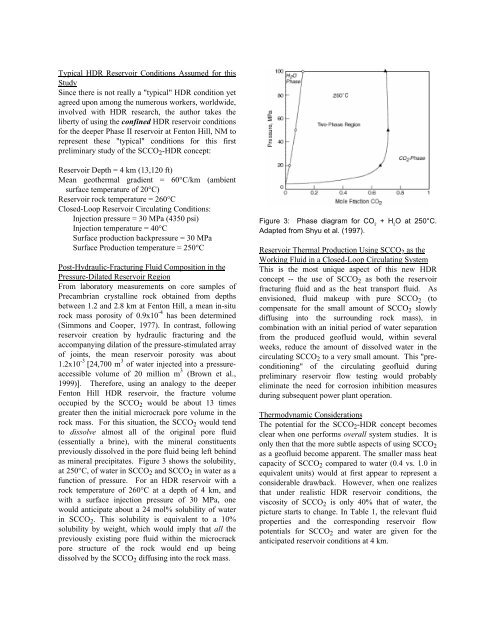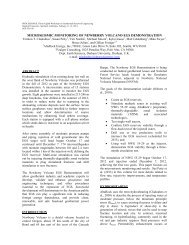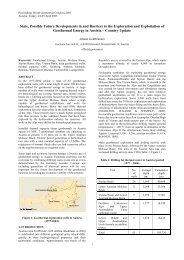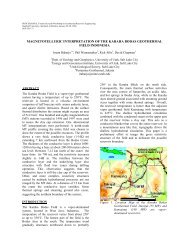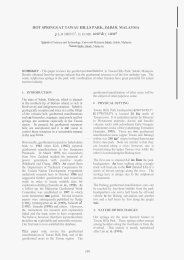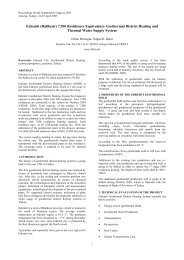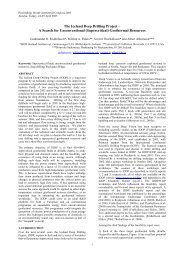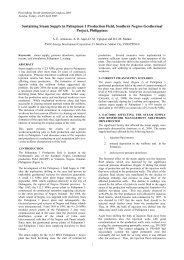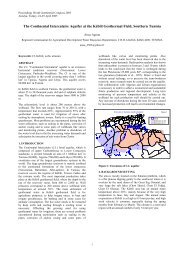A HOT DRY ROCK GEOTHERMAL ENERGY CONCEPT UTILIZING ...
A HOT DRY ROCK GEOTHERMAL ENERGY CONCEPT UTILIZING ...
A HOT DRY ROCK GEOTHERMAL ENERGY CONCEPT UTILIZING ...
Create successful ePaper yourself
Turn your PDF publications into a flip-book with our unique Google optimized e-Paper software.
Typical HDR Reservoir Conditions Assumed for this<br />
Study<br />
Since there is not really a "typical" HDR condition yet<br />
agreed upon among the numerous workers, worldwide,<br />
involved with HDR research, the author takes the<br />
liberty of using the confined HDR reservoir conditions<br />
for the deeper Phase II reservoir at Fenton Hill, NM to<br />
represent these "typical" conditions for this first<br />
preliminary study of the SCCO 2 -HDR concept:<br />
Reservoir Depth = 4 km (13,120 ft)<br />
Mean geothermal gradient = 60°C/km (ambient<br />
surface temperature of 20°C)<br />
Reservoir rock temperature = 260°C<br />
Closed-Loop Reservoir Circulating Conditions:<br />
Injection pressure = 30 MPa (4350 psi)<br />
Injection temperature = 40°C<br />
Surface production backpressure = 30 MPa<br />
Surface Production temperature = 250°C<br />
Post-Hydraulic-Fracturing Fluid Composition in the<br />
Pressure-Dilated Reservoir Region<br />
From laboratory measurements on core samples of<br />
Precambrian crystalline rock obtained from depths<br />
between 1.2 and 2.8 km at Fenton Hill, a mean in-situ<br />
rock mass porosity of 0.9x10 -4 has been determined<br />
(Simmons and Cooper, 1977). In contrast, following<br />
reservoir creation by hydraulic fracturing and the<br />
accompanying dilation of the pressure-stimulated array<br />
of joints, the mean reservoir porosity was about<br />
1.2x10 -3 [24,700 m 3 of water injected into a pressureaccessible<br />
volume of 20 million m 3 (Brown et al.,<br />
1999)]. Therefore, using an analogy to the deeper<br />
Fenton Hill HDR reservoir, the fracture volume<br />
occupied by the SCCO 2 would be about 13 times<br />
greater then the initial microcrack pore volume in the<br />
rock mass. For this situation, the SCCO 2 would tend<br />
to dissolve almost all of the original pore fluid<br />
(essentially a brine), with the mineral constituents<br />
previously dissolved in the pore fluid being left behind<br />
as mineral precipitates. Figure 3 shows the solubility,<br />
at 250°C, of water in SCCO 2 and SCCO 2 in water as a<br />
function of pressure. For an HDR reservoir with a<br />
rock temperature of 260°C at a depth of 4 km, and<br />
with a surface injection pressure of 30 MPa, one<br />
would anticipate about a 24 mol% solubility of water<br />
in SCCO 2 . This solubility is equivalent to a 10%<br />
solubility by weight, which would imply that all the<br />
previously existing pore fluid within the microcrack<br />
pore structure of the rock would end up being<br />
dissolved by the SCCO 2 diffusing into the rock mass.<br />
Figure 3: Phase diagram for CO 2<br />
+ H 2<br />
O at 250°C.<br />
Adapted from Shyu et al. (1997).<br />
Reservoir Thermal Production Using SCCO 2 as the<br />
Working Fluid in a Closed-Loop Circulating System<br />
This is the most unique aspect of this new HDR<br />
concept -- the use of SCCO 2 as both the reservoir<br />
fracturing fluid and as the heat transport fluid. As<br />
envisioned, fluid makeup with pure SCCO 2 (to<br />
compensate for the small amount of SCCO 2 slowly<br />
diffusing into the surrounding rock mass), in<br />
combination with an initial period of water separation<br />
from the produced geofluid would, within several<br />
weeks, reduce the amount of dissolved water in the<br />
circulating SCCO 2 to a very small amount. This "preconditioning"<br />
of the circulating geofluid during<br />
preliminary reservoir flow testing would probably<br />
eliminate the need for corrosion inhibition measures<br />
during subsequent power plant operation.<br />
Thermodynamic Considerations<br />
The potential for the SCCO 2 -HDR concept becomes<br />
clear when one performs overall system studies. It is<br />
only then that the more subtle aspects of using SCCO 2<br />
as a geofluid become apparent. The smaller mass heat<br />
capacity of SCCO 2 compared to water (0.4 vs. 1.0 in<br />
equivalent units) would at first appear to represent a<br />
considerable drawback. However, when one realizes<br />
that under realistic HDR reservoir conditions, the<br />
viscosity of SCCO 2 is only 40% that of water, the<br />
picture starts to change. In Table 1, the relevant fluid<br />
properties and the corresponding reservoir flow<br />
potentials for SCCO 2 and water are given for the<br />
anticipated reservoir conditions at 4 km.


